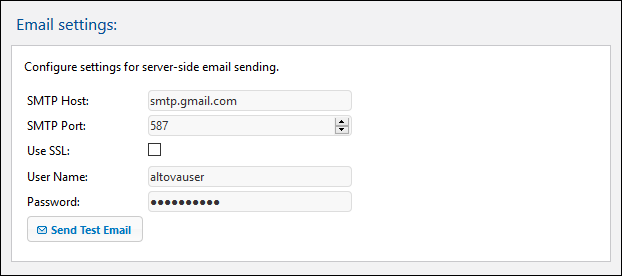Misc
The Miscellaneous (Misc) tab provides settings for a wide range of server features. If you modify any of the settings displayed in this tab, click Save at the bottom of the tab for the modified setting to take effect.
Statistics relating to server usage are stored in an internal MobileTogether database. You can view these statistics by opening the Statistics.mtd file, which is located for new MobileTogether Server installations (version 4.0 and later) in the admin container. The Statistics Limit setting (screenshot below) enables you to specify the time period for which statistics are kept. The default setting is 0, meaning that statistics are not tracked.  Note the following points:
•The admin container is automatically created only for new installations of MobileTogether Server. If you are updating your version of MobileTogether Server, you will need to explicitly deploy the Statistics.mtd workflow to the server. You can deploy it to any container you like, but we recommend that you create an admin container, and deploy it there. •If you need to explicitly deploy the Statistics.mtd design, it is available in the SolutionFiles folder of the AppData folder of your MobileTogether Server installation (see table below). •When you run the solution, it will read data from the internal MobileTogether Server statistics database and provide you with an interface, in which you can filter and select options, to view graphs of the statistics in the database. •The solution shows four main categories of data: (i) the number of users that connect to the server; (ii) the number of different devices that connect to the server; (iii) the number of requests sent to the server; (iv) the number of solution starts that occur on the server (each solution can be started multiple times, and each start counts as an independent start). Additional filtering is also possible (for example, for specific solutions or devices). Note that only solution execution is tracked; administration requests are not tracked. •For a user to be able to read statistics, the Read statistics privilege must be checked for that user.
Location of the MobileTogether Server AppData folder on various operating systems
For detailed information about setting up and using the Statistics solution, see Solution Usage Statistics.
|
Activating the check box allows workflow simulations to be performed on the server for users granted the Run server simulation privilege. 
|
Activating the check box allows workflow execution to be performed from web browsers. 
|
Sets the timeout period in minutes before a new logon has to be performed. This timeout applies to both administrator access as well as client access. 
|
This setting (screenshot below) concerns a procedure related to upgrades of your MobileTogether Server from one version to a higher version. By default, a backup folder containing all important server files and folders is created when a new MobileTogether Server version is installed. When you de-install an existing MobileTogether Server installation, these MobileTogether Server files and folders are still held in the system. Subsequently, when a new MobileTogether Server package is installed, this data is copied into a backup folder that is created in the MobileTogether Server application folder.  This setting enables you to disable the automatic backup for the next upgrade. You can always manually create a backup folder at any time. See the section How to Back Up and Restore MobileTogether Server for information about how to do this.
|
These settings enable emails to be sent by the end user via the server. Typically, the solution will provide an event that triggers a Send Email action that has been defined to send the email from the server. In order for the server to do this, it needs to access the SMTP server of the email service provider (usually your ISP). The settings for the SMTP server are entered in this pane (screenshot below).  •SMTP Host and SMTP Port: These are the SMTP host name and SMTP port of your ISP's SMTP server. These details are provided to you by your ISP. •Use SSL: Specifies whether SSL is used or not. •User Name and Password: The user name and password of an email account that is registered with the email service provider.
|
